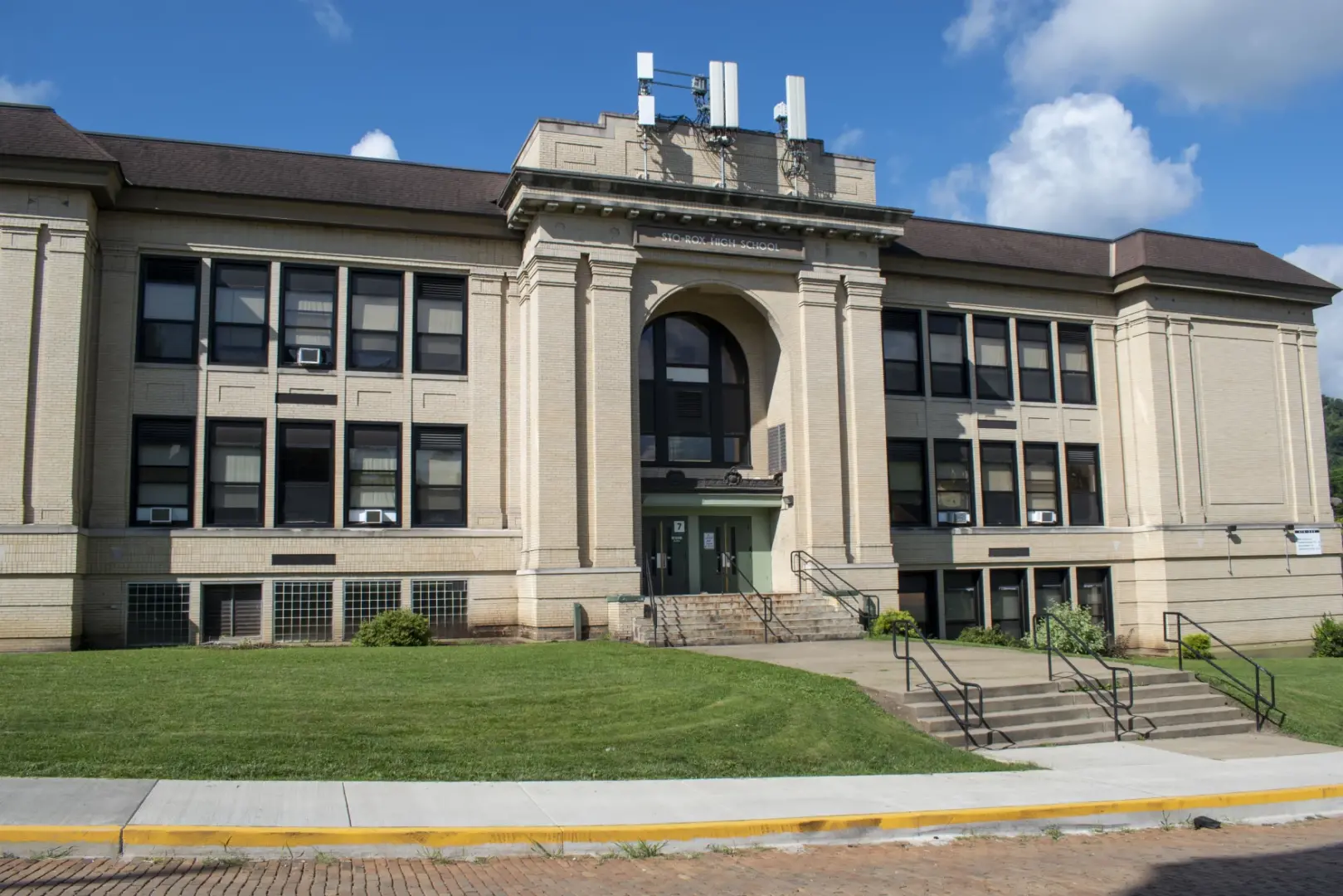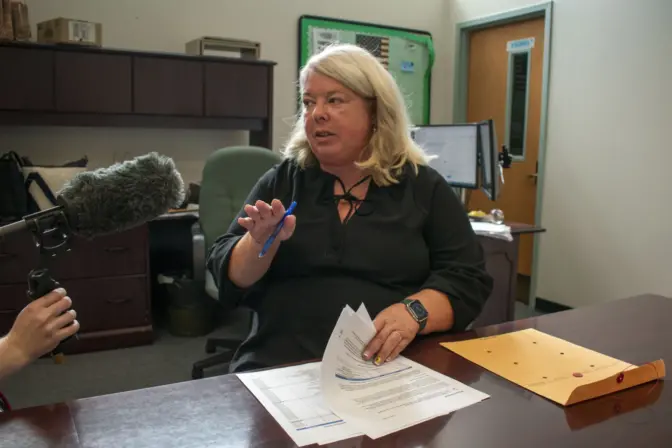
Sto-Rox Junior-Senior High School opened in the 1920s. Like any 100-year-old facility, it requires major upgrades district officials say they don't have the resources to pay for.
Jakob Lazzaro / 90.5 WESA

Sto-Rox Junior-Senior High School opened in the 1920s. Like any 100-year-old facility, it requires major upgrades district officials say they don't have the resources to pay for.
Jakob Lazzaro / 90.5 WESA

Jakob Lazzaro / 90.5 WESA
Sto-Rox Junior-Senior High School opened in the 1920s. Like any 100-year-old facility, it requires major upgrades district officials say they don't have the resources to pay for.
For Sto-Rox — a small school district just west of Pittsburgh — the more than $14 million windfall in federal COVID-relief funds received over the last few years was sorely needed.
“If we didn’t have it, we would not be where we are,” said Superintendent Megan Van Fossan. “[It’s] that simple.”
At the start of the pandemic, Sto-Rox had a fund balance of negative $6.6 million. The federal money the district received went, in part, toward filling that hole: By the end of the 2021-2022 school year, district leaders had brought the budget deficit down to just under $2 million.
School officials expect an audit of the school’s budget this fall to show a positive fund balance for the first time since 2016.
“We have our fingers crossed that we have an okay fund balance,” Van Fosssan said. “It’s not going to be what we want it to be, but we are hoping we’re out of the red.”
Multiple rounds of federal COVID relief dollars over the last couple of years, known formally as Elementary and Secondary School Emergency Relief (ESSER) Funds, have made it possible for Sto-Rox and other struggling Pennsylvania schools to chip away at long-standing budget gaps.
But the majority of funding will expire this month, and the last allocation of funds must be used by September 2024. With its disappearance looming, district leaders have been left to grapple with how to make the progress they made sustainable.
Since 2020, Pennsylvania has received more than $7 billion in ESSER funds, intended to help school districts across the Commonwealth respond to learning disruptions and other complications created by the COVID-19 pandemic.
Sto-Rox received $14.2 million of that funding for its students, who come from both McKees Rocks and Stowe Township. It’s a once-in-a-generation influx of funds for a district that relies heavily on state and federal revenue sources.
Despite having one of the highest local tax rates in Allegheny County, the district’s ability to collect local revenue is limited. The median property value in McKees Rocks is $30,800, and $37,200 in Stowe.
The district raised local taxes in 2021, 2022 and 2023 to muster more funding for its students, but even so, Sto-Rox’s tax value sits far below that of districts with lower tax rates. Local revenue made up just 26% of the district’s total budget for the 2022-2023 school year.
(By comparison, local revenue comprises 50% and 79% of the total revenue, respectively, in nearby Pittsburgh and Montour school districts.)
“People tend to leave, the businesses are leaving and no one’s coming in and renting those facilities or buying those facilities,” Van Fossan said. “It does make it harder on the local taxpayers. The money has to come from somewhere, and I think that’s why we’re in a recovery plan.”
A 2021 audit found that the district had a balance deficit of more than $5 million. One month later, the Pennsylvania Department of Education deemed Sto-Rox a district in “moderate financial recovery”, thus requiring school officials to create a plan to get on better financial footing.
Much of the COVID relief funding Sto-Rox received has since gone to that end. After using much of the ESSER I and II funds to purchase remote learning equipment and cleaning supplies, the remainder went toward filling the district’s operating gap.
Subsequent rounds of funding went to patching that same hole. District leaders funneled the COVID relief money into budgetary reserves to be pulled from as expenditures came up.
As a result, roughly 80% of the total COVID funds spent so far have gone to pay teacher salaries and benefits, with the remainder put toward technology, supplies, and buildings, according to district officials.
Of the $14.2 million the district has been allocated, $11 million has been spent to date. Because of that, little has remained for immediately addressing facility woes.
Walking through Sto Rox Junior-Senior High School earlier this month, Van Fossan pointed out water damage on ceiling tiles. Inside the building, built in the 1920s, carpet needs to be replaced, and plaster has fallen from a bathroom ceiling.
“Obviously, we’ll clean that up before kids come in,” she stressed. “But that’s what you find in older buildings when it gets warm.”
But maintaining the facility long-term, along with the district’s other school buildings, will require more than $14 million in upgrades and repairs. Most critically, all three of the district’s school buildings need urgent roof repairs to prevent leaking when it rains, in addition to boiler replacements that are expected to cost $1.5 million.

Jakob Lazzaro / 90.5 WESA
Sto-Rox School District superintendent Megan Van Fossan says maintaining the district’s junior-senior high school long-term, along with the elementary schools, will require more than $14 million in upgrades and repairs.
At the lower and upper elementaries, the H-VAC systems, too, have reached the end of their lives. None of this is out of the ordinary, especially in older buildings, but dealing with it requires the kind of ongoing financial resources Sto-Rox doesn’t have, even with the COVID funds in hand.
“That was a one-time phenomenon, and that level of federal money coming in is not sustainable,” said Patrick O’Toole, the district’s chief recovery officer. “We can’t rely on that.”
O’Toole, who was appointed by the state to guide the district as part of the financial recovery process in January, is now helping make a number of cuts to save costs.
“We negotiate every contract, we try to get to the best financial agreement possible for the district, we try to share services. Where we can, we cut back,” O’Toole said. “There’s a superintendent here and a special education director, and other than that, there’s no central office. It’s been cut to a lean staff.”
But, perhaps counterintuitively, much of his work has focused on helping the district invest more. The district used the COVID money to raise teacher salaries to encourage retention after years of resignations and high turnover.
Roughly a third of all 1,800 students in the district are enrolled in charter schools and — per state law — tuition comes out of the district’s coffers. Those payments account for roughly 20% of Sto-Rox’s total budgeted spending annually.
“So you can’t just strip away everything and expect kids to stay — they’ll leave,” O’Toole added. “And the check you write to the local charter school just increases.”
Sto-Rox isn’t alone in this. Statewide, the percentage of school district budgets going to charter tuition payments doubled between the 2010-2011 school year and 2020-2021.
According to a survey by the Pennsylvania School Boards Association, charter payments were named the biggest source of budget pressure among school districts four years in a row.
Andrew Christ, PSBA’s director of education policy, said COVID relief funds have helped districts bolster mental health services and other kinds of programs that could attract families back from charter schools. Still, that won’t immediately stop the bleed.
“No matter what, if that kid decides to leave the school district for a charter school, our school districts have to pay that bill,” Christ said. “When it comes due, we have to pay that regardless of whether we’d like to or regardless of what our budget situation is.”
Increased funding for public schools included in the state budget is expected to create a buffer for school districts as they face the sharp decline in federal funding. The adopted budget increases basic education funding by $567 million — the largest increase of that kind in Pennsylvania history. Sto-Rox is slated to receive a 15.5% increase in basic education funding from last year.
And once lawmakers negotiate the necessary code bills, Sto-Rox is expected to receive a share of the $100 million Level Up fund for the state’s poorest 100 schools.
Even so, officials with Sto-Rox and other districts that used their COVID funding for teacher salaries and recurring expenses — despite warnings not to — will now need to look for new ways to pay for those ongoing expenses.
To prevent that from turning into yet another budget hole, schools like Sto-Rox will need to figure out how to get enrollment back up so that their dollars aren’t funneled to other schools.
“And if we can bring those kids back from brick and mortar and cyber charter schools, we’ll be okay,” Van Fossan sighed. “We really will be okay. That’s the key.”

Sometimes, your mornings are just too busy to catch the news beyond a headline or two. Don’t worry. The Morning Agenda has got your back. Each weekday morning, host Tim Lambert will keep you informed, amused, enlightened and up-to-date on what’s happening in central Pennsylvania and the rest of this great commonwealth.
The days of journalism’s one-way street of simply producing stories for the public have long been over. Now, it’s time to find better ways to interact with you and ensure we meet your high standards of what a credible media organization should be.